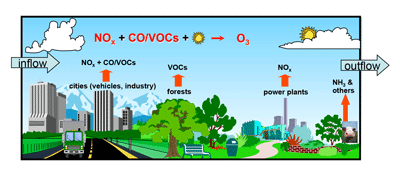A .gov website belongs to an official government organization in the United States.
A lock () or https:// means you've safely connected to the .gov website. Share sensitive information only on official, secure websites.
14 January 2016

On January 25-27, the international Tropospheric Ozone Assessment Report (TOAR) will hold a meeting to review the first draft of the seven scientific chapters of the first scientific assessment on the topic of ozone in the lower atmosphere (troposphere). About 50 scientists, including both authors and reviewers, will converge in Beijing to determine major issues that will guide the preparation of the chapter second drafts, and to make a preliminary identification of the major scientific findings of each of the chapters.
Tropospheric ozone (O3) is important both as an air pollutant and as a greenhouse gas. It is formed as a secondary pollutant when volatile organic compounds (VOCs) and nitrogen oxides (NOx) react in the atmosphere. VOCs and NOx are emitted from both natural and anthropogenic sources. Emissions from fossil fuel burning, power plants, industrial activities, and other human activities have increased tropospheric ozone above its natural background globally, and more locally have led to ozone episodes that are harmful to human health, ecosystems, agriculture, and materials. In the U.S., ozone is one of six criteria pollutants subject to regulations under the U.S. Clean Air Act.
The Beijing meeting is a major milestone in the process for completing the TOAR report, which will be the first international "state-of-the-science" assessment on the topic of ozone in the lower atmosphere. It specifically aims to provide the research community with an up-to-date scientific assessment of tropospheric ozone's global distribution and trends from the surface up to the tropopause (the boundary between the troposphere and the stratosphere).
The multi-year effort to produce the TOAR assessment is being organized under the auspices of the International Global Atmospheric Chemistry (IGAC) project, with support from NOAA and the World Meteorological Organization. TOAR is led by Owen Cooper, a scientist with the Cooperative Institute for Research in Environmental Sciences (CIRES) at the University of Colorado Boulder, working at the NOAA ESRL Chemical Sciences Division. Other NOAA and Cooperative Institute scientists are participating as authors and reviewers, including scientists at the NOAA Earth System Research Laboratory (ESRL) Chemical Sciences Division, the ESRL Global Monitoring Division, and the Geophysical Fluid Dynamics Laboratory and its Cooperative Institute at Princeton University.

The location of the meeting in Beijing is especially appropriate. Since 1990, a large portion of the anthropogenic emissions that react in the atmosphere to produce ozone have shifted from North America and Europe to Asia. This rapid shift has left scientists scrambling to answer basic scientific questions about the locations, causes, and impacts of high ozone pollution, because the monitoring of ozone is sparse in many regions of the globe, particularly developing nations. In addition to reviewing the first draft of the TOAR assessment's chapters, the meeting in Beijing will include presentations by Chinese scientists regarding ozone research in China. The meeting has encouraged many Chinese scientists to become new members of the TOAR community.
In addition to the chapter teams, TOAR has established 7 regional working groups to gather surface ozone time series from around the world, a working group that focuses on free troposphere and satellite ozone observations, and a working group on metrics, statistics, and tools. The aim of this aspect of the TOAR project is to generate easily accessible ozone exposure and dose metrics at hundreds of measurement sites around the world (urban and non-urban), freely accessible for research on the global-scale impact of ozone on climate, human health, and crop/ecosystem productivity.
Preparation and review of the TOAR assessment report will continue throughout 2016, with completion of the report expected in late 2016. The TOAR chapters will be published as papers in a peer-reviewed scientific journal in early 2017, capping a more than two-year effort that began in late 2014.